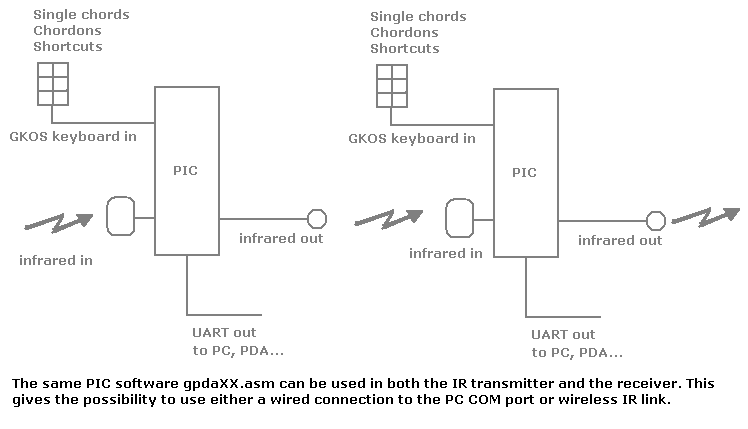www.gkos.net

GKOS
Keyboard
Drivers
On
this page, drivers that can be used to
receive key press data from
the Universal GKOS IR Keyboard
are available. Input to PCs and PDAs
goes through wires (COM port / RS232)
of by infrared (IrDA port). If
you
design one for your device, please let others also benefit from that!
Latest drivers can be found on
the page of Project 4 - the
Universal Serial PC Interface.
Older stuff:
1. A Driver for Receiving
GKOS Keycodes on a COM Port of a PC
A. The GKOS PC COM port keyboard
driver
for Windows 95/98 only - No mouse
functions
This
is the first driver software, designed to receive Keycodes tranmitted
by the Universal GKOS IR keyboard
through its UART port (wired, 9600
bits/s, 8, N, 1). The UART signal levels (0/5 V) need to be adjusted to
those of the RS232 COM port (+/- 12 V). The circuit
for that can be found on this wesite. Alternatively, the new Project 4 is a more elegant
and simpler solution.
The driver converts the
received GKOS Keycodes to corresponding key presses on the PC so
that both the GKOS keyboard and the PC's own
keyboard operate at the same time. No GKOS mouse operation is supported.
The operating mode of the Universal GKOS IR keyboard shall be changed
to CHORD mode (by typing [SYMB] [Ctrl] c [Enter] or by
changing the default in the asm file). - The driver (Visual
Basic 3.0 design, Win95/98 only!) can be found here (gkosdrv2.exe, version 0.2).
The source code
is available
within the driver files (in text files as well) for those who plan to
develop their own drivers on different platforms
(Windows NT/2000/XP, PDA, Linux, Series 60/90, Symbian etc.)
RECOMMENDED
FOR CONNECTING TO A PC:
B. The GKOS PC COM port Keyboard/Mouse driver for Windows
95/98/NT/2000/XP
A new driver for the PC has been developed using C++ (My first C++ WIN32 project!).
It receives wirelessly Keycodes tranmitted
by the Universal GKOS IR keyboard.
They are input through the COM port
of the PC (wired, 9600
bits/s, 8, N, 1). See Project 4 for the
schematic etc. The driver
converts Keycodes into PC
key presses as well as mouse movement and clicks. Mouse
functions for Keycodes have been defined here.
The latest versions of this driver supports all features of
GKOS (See Project
4).
grdv21c.exe
(version 0.21c). This single exe file is a fully functional draft version
of
the driver. It has been tested on Windows 95, 98, 2000 laptops and on a
Windows XP desktop. In fact, it is not a typical driver because it is not loaded at
PC start-up but can be started any time you plug in the universal GKOS
interface on the serial port. - Check this page for later
versions of the driver.
_______________________________________________________________________________________
Do not get mixed up with the images and text below. They are just
additional information. Driver B above is recommended if you plan to
connect the GKOS keyboard to the PC. See
Project 4 for latest driver
versions and more information.
Principle of possible
connections:

---
- The
driver above
assumes that the key codes are input
through a serial COM port of the PC so it might also be possible to use
the IrDA port if that can somehow be configured to appear simply as a
COM port (e.g. COM3) without any 'over-specified' IrDA protocols
involved. Each GKOS key
code, when sent as IrDA frames, consists of three frames (Header, IR
device address and the actual Key Code). To enable reception of
three fames per key code, select the IrDA option (IrDA/RS232) at the settings menu of the
driver.
2. Next Driver...
Your design? (you can present it on Discussion forum) ... or maybe you have the
tools to make my VB 3 software run on Windows2000/XP? Main function of
the driver is in brief: Receive GKOS Key Codes on a serial port and
convert them to corresponding key presses. See the source of the VB
driver
above for details.
3. Hardware


